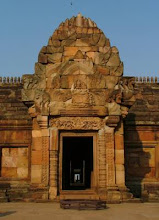
Of traditional festivities the oldest take place every year at full moon in the 5th lunar month, April. Every year one the full day the locals ascend the mountain from all the nearby villages and perform Hinayana Buddhist rites followed by musical shows and dance.
This kind of 5th-month-lunar-ceremonies has been described by the first foreign explorers visiting the area in the late 19th century and probably goes much further back. The participants are the local ethnic Khmer and Lao farmers and this festival is still the ngan the elder people care the most for.
It does not coincide with the days when the rising sun is visible through the temple. Descending mountains or making ngan at the full moon in April is not a phenomenon limited to Phanom Rung. At many other ancient sites in Isan the locals chose the same day for performing their traditional ceremonies. Other rituals of more private are conducted throughout the year, mostly in connection with full moons. The author has often met traces of nightly ceremonies, when arriving early morning for solar observations.
The second ngan is preformed by members of the Thai Hindu population and most of the participants come from Central Thailand, particularly from Bangkok. The author is not aware of how long time back the Hindu rites have been preformed. The Brahmins choose the occasions when the rays of the rising or setting sun penetrates the doorways of the sanctuary and the author has met them on several occasions since the late nineties.
Right: Bangkok people preforming Bramin rites before sunrise at the western gate of Prasat Phanom Rung in October 2000. Since Prasat Phanom Rung in the beginning of the nineties became Phanom Rung Historical Park, a new annual festival was introduced: The annual ascending of the mountain on the day of the solar event. The festival probably has its inspiration in the traditional full moon festival in April, and was fixed to a date in the beginning of April. The date did not coincide with the solar event because of incorrect dating. Neither did it coincide with the full moon, which does not fall on a fixed date, due to the difference of the length of the solar and the lunar year. And only one solar event was
 taken into consideration.
taken into consideration.Authorities like Thai Tourism refused to recognize that there actually are four annual solar events: Two sunrises and two sunsets. An article by the author in Bangkok Post, March 2000, did not change their view.
Only after that the author invited the director of Phanom Rung Historical Park, achan Nongkram Suksom, to watch the sunset in March 2003, things changed. Next day the governor of Buriram province was present and happily the sun broke through the clouds just before reaching the horizon. This impressed the governor to an extend that the month from the sunset in March 2004 to the sunrise in April was declared for ''The Holy month of Prasat Phanom Rung'' and ritual were preformed on both occasions.
Only after that the author invited the director of Phanom Rung Historical Park, achan Nongkram Suksom, to watch the sunset in March 2003, things changed. Next day the governor of Buriram province was present and happily the sun broke through the clouds just before reaching the horizon. This impressed the governor to an extend that the month from the sunset in March 2004 to the sunrise in April was declared for ''The Holy month of Prasat Phanom Rung'' and ritual were preformed on both occasions.
On the latter there is a 2-3 days festival with a colourful ascending of the mountain and in the evenings there are concerts and Light and Sound Show with the performance of a historical show. It can be questioned to what degree these shows are authentic, as we have no written evidence of ancient rites or mountain-ascending. But amazing is it...
Right: Ascending Phanom Rung in April 2003.
Below: Brahmin rites performed mostly by employees of Phanom Rung Historical Park in April 2003.
Below: Brahmin rites performed mostly by employees of Phanom Rung Historical Park in April 2003.
Ngan Shiva Ratree, March 5, 2004:
Above: Apsaras (celestial nymphs) at Prasat Phanom Rung.
Right: Dancing apsaras below Shiva Nataraya, the 'King of Dancers'.
Left: new and old...
Right: Waiting...
Right: Waiting...
First day of the annual Light and Show Festival at Prasat Phanom Rung, April 2, 2004:














ไม่มีความคิดเห็น:
แสดงความคิดเห็น